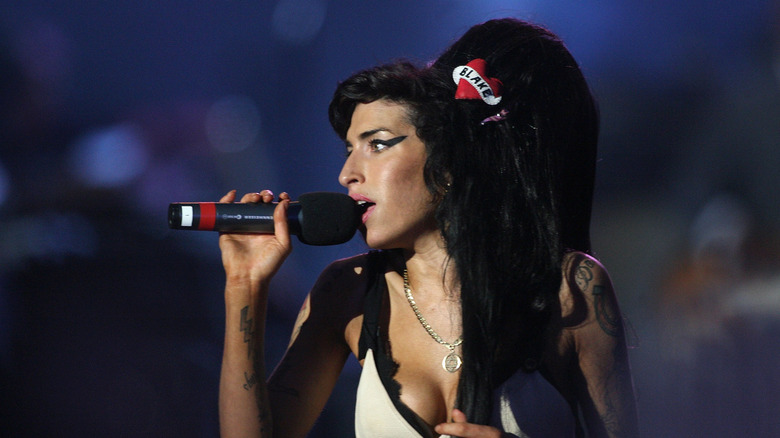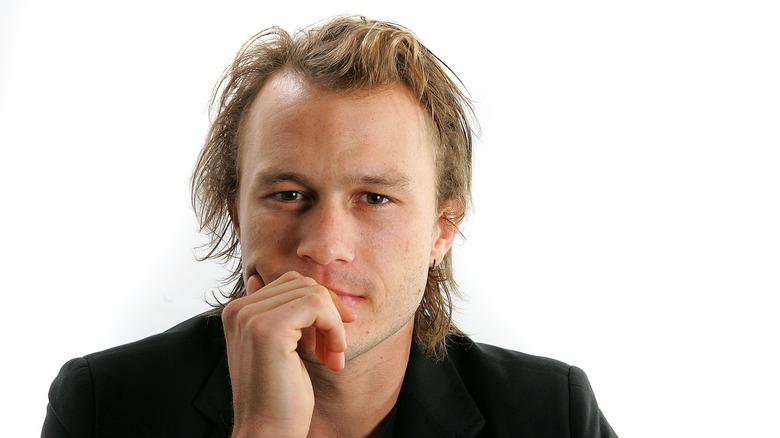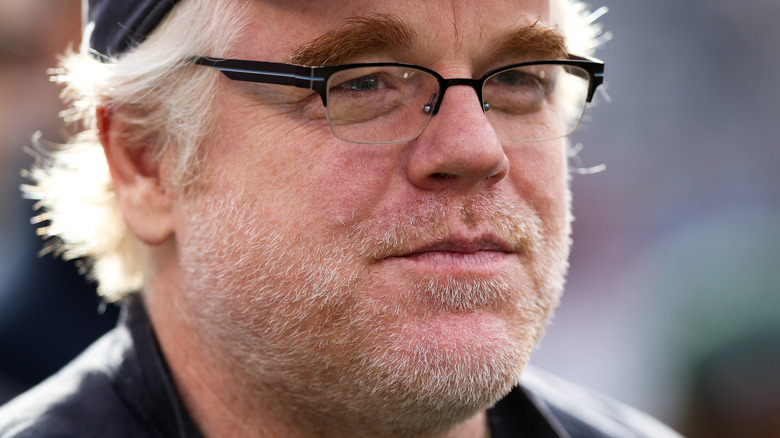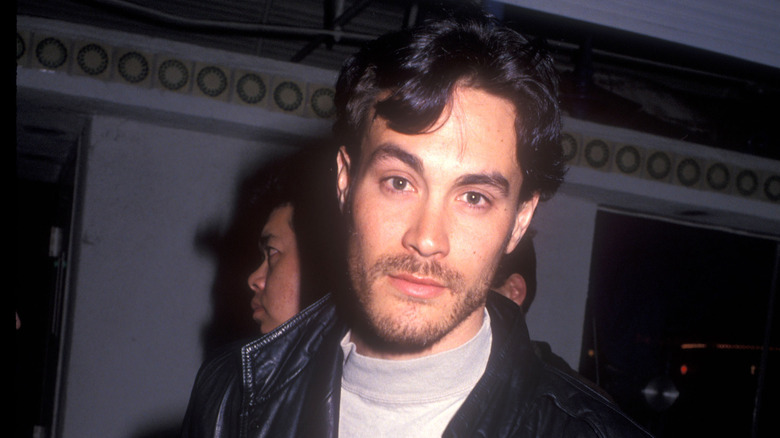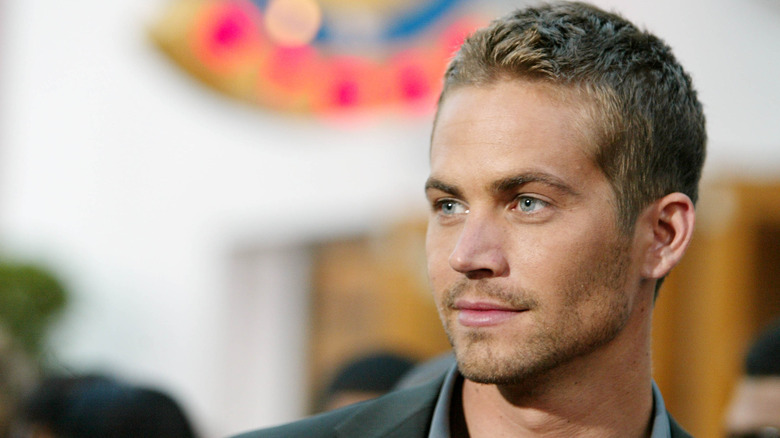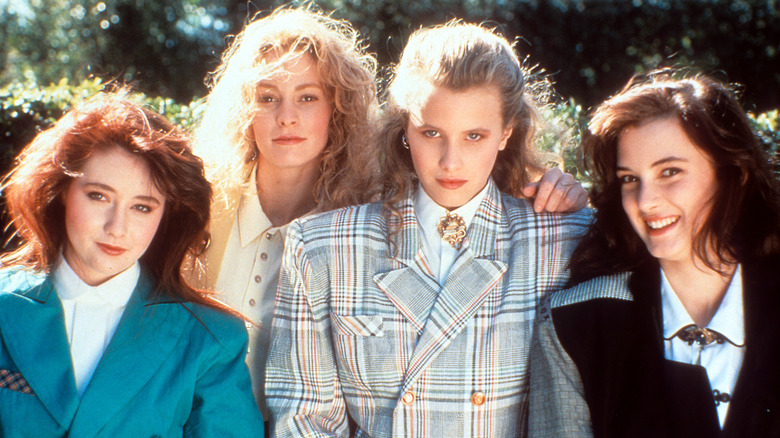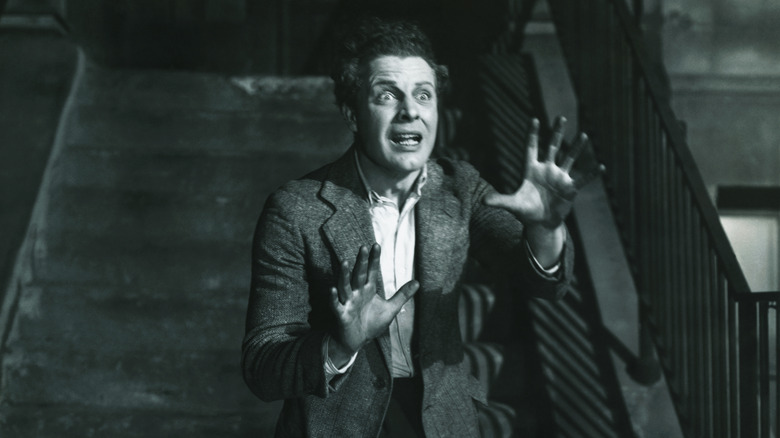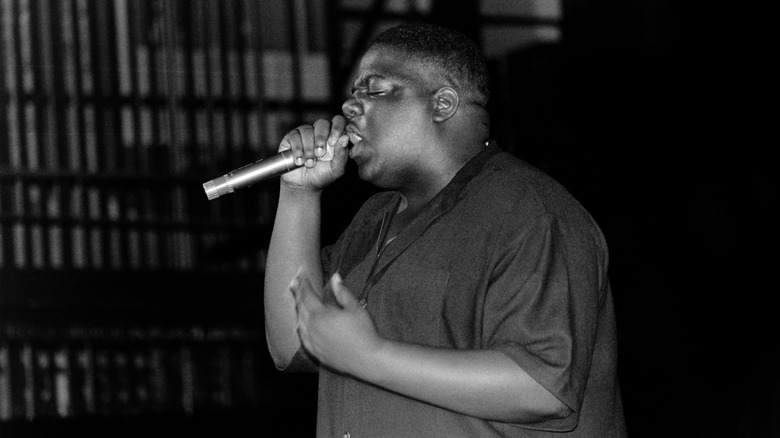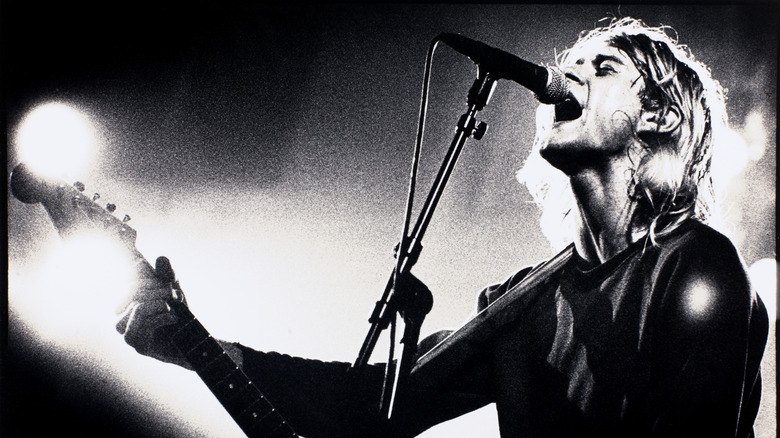These Stars Who Died Young Share A Chilling Connection
Foreshadowing is a clever storytelling device, usually deployed in fiction, which gives the audience a tantalizing sense of the events that occur later in the tale, usually during a dramatic climax. But foreshadowing can occasionally leave the world of fiction and spill out into real life, often with chilling results, and this is especially the case with celebrities famous for their work in the arts.
When an artist dies young, it is an event that casts a tragic light over their life and work, often adding to their legend and mystique in the process. But sometimes, in an instance of real-life foreshadowing, their deaths are echoed in their earlier work, an uncanny occurrence that has happened a surprising number of times in tragic circumstances. Here are some stars from the world of entertainment — whether they be actors or musicians — whose untimely and tragic deaths were eerily foreshadowed in their work.
Heath Ledger
When Heath Ledger died suddenly of an accidental overdose on January 22, 2008, at the age of just 28, much of the lore around his tragic death focused on his role as the Joker in the then-upcoming Batman epic, "The Dark Knight." The role was a defining one for Ledger, who made no secret of the freedom he had been given to make the Joker his own, and openly discussed the psychological depths he had to plumb to embody the face-painted nihilist and psychopath.
However, "The Dark Knight" wasn't Ledger's final film. At the time of his death, he had taken a lead role in "The Imaginarium of Dr. Parnassus," and director Terry Gilliam has recalled the horror the crew felt as the news of Ledger's death trickled through. Keen to ensure Ledger's final role made it to the screen, Gilliam decided that the fantastical character could be played by several actors, including Ledger, with the character's look changing each time he passed through a magic mirror.
Ledger's friends Johnny Depp, Jude Law, and Colin Farrell stepped in to complete the picture. The finished film includes multiple references to death, which Gilliam insists were already in the script before Ledger's demise. "They all thought we had written this stuff after Heath had died and no, we didn't change any of the words," said Gilliam (via cinema.com). "And that to me is what [is] so kind of scary and spooky – why was it so prescient? It seemed to be all about death, it's so much of it."
Philip Seymour Hoffman
The world of film was in deep mourning in 2014, when it was revealed that the beloved Oscar-winning actor Philip Seymour Hoffman had died. Hoffman had worked with some of the greatest directors of his era, including Paul Thomas Anderson and the Cohen Brothers, and had been found dead following a fatal drug overdose in his rented apartment in Greenwich Village, New York. He was 46.
Initial reports of his death were sketchy. Some speculated that he had been the victim of a deadly batch of heroin. However, it later transpired that he had several commonly misused drugs in his system, of which heroin was one. Hoffman had been open in interviews about his drug addiction and alcoholism, and though he went through periods of sobriety — he first gave up drugs and alcohol at the age of 22 – an addiction to prescription drugs unfortunately led to a return to heroin. He had checked himself into a rehabilitation clinic a year before his death.
In the wake of the tragic news, outlets noted how addiction had featured in several of his most acclaimed roles, most notably "Before the Devil Knows You're Dead," in which he portrayed a desperate heroin misuser whose addiction forces him to turn to crime.
Brandon Lee
Brandon Lee, the son of martial arts icon Bruce Lee, was on the verge of becoming a Hollywood superstar — just like his father — when he tragically died at the age of 28. He had just won the title role in "The Crow," a tale about a gothic superhero that was famously beset by production issues. To achieve a dark tone, the movie was filmed entirely at night, a creative decision that caused accidents and delayed production. But production hell turned to horror when on March 31, 1993, Brandon, who was filming his character's death scene, was killed by a live bullet in a prop gun.
Brandon's father had also died tragically young at the age of 32, having fallen into a coma after taking a prescription painkiller. The cause of death has often been reported as cerebral edema, though Bruce's death has been shrouded in mystery since it first hit the news in July 1973.
Following Brandon's death, rumor had it that there was a curse on the Lee family, a macabre aspect to the story heightened by his starring in the dark "The Crow." The gothic imagery of Brandon's last movie, including the fact that his character was resurrected from the dead, added to the spookiness. It also ensured that "The Crow" remained a cult classic among viewers, for whom Brandon's untimely death is part of the mythos attached to the film, and which represents his celluloid afterlife.
Paul Walker
The actor Paul Walker became one of America's most bankable stars during the 2000s, thanks to his leading role in the "Fast & Furious" movie franchise. Alongside his co-star Vin Diesel, Walker became a hero to car-loving moviegoers everywhere, whose on-screen charm was only increased by the fact that he was just as much of an engine-head in real life as he was portrayed in the movies.
Tragically, on November 30, 2013, Walker was traveling in the passenger seat of a 2005 Porsche Carrera GT when his friend Roger Rodas, who was driving, lost control of the vehicle at high speed and collided with a tree, which caused the vehicle to catch fire. His autopsy concluded that the impact and flames contributed to his death.
At the time of his death, Walker had been busy filming "Fast & Furious 7," and reshoots had to take place using his two brothers, who both bear a striking resemblance to the actor, as stand-ins. The movie was an immense box office success, though to see Walker on screen frantically driving when it was known the actor had just perished in a violent crash undoubtedly made the experience unsettling for many viewers.
Kim Walker
Before there was "Mean Girls," there was "Heathers," a 1989 classic black comedy about high school alienation, standing up to bullies, and premeditated murder. Starring Winona Ryder and Christian Slater as a pair of teenage love interests resisting the cruel social power of a trio of popular girls, all of which are called Heather. The movie is famous for its withering put-downs and caustic one-liners, though few of its cult fans will be aware that the script also contains a cruel foreshadowing of the tragic early death of one of its actresses.
Among the cast is Kim Walker (third from left), who plays the trio's leader, Heather Chandler. Chandler, the most brutal of the popular girls, is eventually killed after drinking poison, but not before delivering some of the movie's most memorable lines, including: "Did you have a brain tumor for breakfast?" Sadly, the line must now be taken with a dose of tragic irony, as Walker, whose career in movies continued after her breakout role in "Heathers," died in 2001 of a brain tumor at the age of just 32.
James Murray
The tale of James Murray is perhaps one of the most tragic and disturbing in the era of early cinema. In 1901, Murray was born in Manhattan to an Irish family, one of nine. He was raised in the Bronx, and once grown, he worked as a doorman and a film extra before being spotted by director King Vidor, who decided to cast him in his 1928 film "The Crowd," now considered a cult classic.
"The Crowd" tells the tale of starry-eyed Johnny Sims, a young man seeking opportunity in New York during the Great Depression. Experiencing poverty, death, and marital strife, Sims' life spins out of control and he ends up close to destitution and death by suicide. Though "The Crowd" deals with heavy themes, the studio insisted it must have a happy ending, with the Sims family eventually settling into a contented but unexceptional life.
Murray was not quite so fortunate. After "The Crowd," he continued to act, but in later years drank heavily, and eventually was seen begging on the streets by none other than Vidor himself, whom Murray cursed when Vidor offered to put him in another film. Murray died after performing — presumably while intoxicated — for a group of fellow drinkers, balancing on Pier 46 and falling into the Hudson River, in which he drowned.
Amy Winehouse
The tragic final years of Amy Winehouse's life were like a slow-motion car crash for her fans, who saw her deteriorate visibly as the strains of pop stardom took hold. Pursued mercilessly by the tabloid press, the British singer became known for her alcoholism and, eventually, her misuse of hard drugs, with the encroachment of the paparazzi into her private life reportedly taking a toll on her mental health. Winehouse was found dead in her London apartment from alcohol poisoning at the age of 27.
Winehouse's addiction issues didn't come out of nowhere. In fact, her breakout single, "Rehab," outlined exactly how she found herself choosing to resist treatment for, she believed, the sake of her career. In it, she sings: "They tried to make me try to go to rehab, I said no, no no ... I ain't got the time, and if my daddy thinks I'm fine..." As her manager Nick Shymansky noted for The Independent, the song mirrors real-life discussions about her health that were occurring among her team just as she was gaining international fame, but which were sadly derailed by those around her.
"Rehab," which was released in October 2006 ahead of her Grammy-winning sophomore album "Back to Black," now sounds horribly prescient. Not least the mention of her father, who has become something of a villain among her fanbase. As Shymansky points out, Winehouse was dead within five years of the song's release, writing its unheeded warning all the greater.
Marc Bolan
Another tragic British music icon is Marc Bolan, who, like Amy Winehouse, exerted an extraordinary influence on the artists who would come in his wake. A trailblazer of the glam rock movement with his band T. Rex, Bolan's work reverberated in the songs of major contemporaries such as David Bowie, and continues to shape the sound of more modern indie artists, such as Devendra Banhart.
Bolan was killed in a car crash on September 16, 1977, at the age of just 29. Even by that relatively young age, the rocker had already amassed a sprawling discography, including ten singles that reached the top ten in the British charts (although his influence on American artists is undeniable, "Get It On" was T. Rex's only major single in the U.S.). And weirdly, some fans believe that there is a song in Bolan's catalog that appears to predict his death.
In the 1972 single "Solid Gold Easy Action," Bolan sings: "Life is the same and it always will be / Easy as picking foxes from a tree." As it happens, "FOX 661L" was on the license plate of the vehicle in which Bolan lost his life. In another spooky coincidence, it was reported that the car collided with a tree.
Notorious B.I.G.
Death was a central subject in the work of seminal '90s rapper the Notorious B.I.G., aka Biggie Smalls. Before proving his abilities as one of the most versatile and imaginative rappers of his generation, Smalls lived a precarious life as a drug dealer, the dangers of which were writ large in his lyrics. While still a teenager, Smalls was arrested for illegally possessing a firearm, with the threat of gang violence seemingly never far away. But Smalls outlined other threats too, not least death by suicide, which is the theme of "Suicidal Thoughts," the final track of his debut album "Ready to Die," and which also underpins the album's title.
Smalls was shot to death after leaving a party in Los Angeles on March 9, 1997. The murder, which has never been solved, came after rising tensions between Smalls, an East Coast rapper, and his former friend and bitter rival Tupac "2Pac" Shakur, a West Coast star who was killed the previous year. It also came two weeks before the release of his sophomore album, the title of which, "Life After Death," was intended to suggest a continuation of the journey outlined in "Ready to Die." In retrospect, both titles seem to uncannily predict the untimely demise of the iconic rapper, who was just 24 years old when he died.
2Pac
The murder of 25-year-old Tupac Shakur, aka 2Pac, on September 13, 1996, was the highest profile slaying in a coastal feud that had engulfed rap music after the rise of gangsta rap. Shakur first made his name with danceable rap with the group Digital Underground and cracked the top 40 with the single "The Humpty Dance," but in the early stage of his career soon undertook a radical change in style, embracing what he termed "thug life" and embodying the lifestyle in both his records and his acting roles.
Though critics argued that Shakur's music glamorized the gangster lifestyle, his output showed that he was conscious of its dangers, and numerous songs see the rapper mulling over premonitions of his untimely death. In "Only God Can Judge Me," Shakur imagines himself on a hospital bed, dying painfully from bullet wounds. Meanwhile, the music video for the single "I Ain't Mad At Cha," which you can watch below, sees a white-suited Shakur rapping in the back of a vehicle before ascending to heaven, strangely mirroring his death in a drive-by shooting. Then there's his last movie, "Gang Related," in which his character is shot to death.
Kurt Cobain
Nirvana were the kings of the 1990s grunge movement, a musical genre mainly out of Seattle which valued raw authenticity over the posturing and decadence of the previous generation's hair-metal musicians. Nirvana frontman Kurt Cobain was an artist especially concerned with authenticity, which flavored both his music and his pronouncements in interviews about the band's career, the state of the music industry, and the world in general.
Cobain was also open about his mental health issues, which were in turn related to chronic pain he experienced for many years as a result of a stomach ailment. Cobain, who claimed to have suicidal ideation as a result of the pain, began to self-medicate, which included the misuse of heroin. Cobain admitted in an interview with Rolling Stone toward the end of his life that pain underpinned much of his songwriting with Nirvana, some songs of which allude to death by suicide.
One of the darkest titles in the Nirvana catalog is a demo titled "I Hate Myself and Want to Die," which was recorded during sessions for the band's final studio album, "In Utero." Strangely, the song contains no lyrics that reflect the title, though the later revelation that it was the working title for the album make the sentiment more prescient than it may first appear. Cobain died by suicide at his home in Seattle, at the age of 27.
If you or anyone you know needs help with addiction issues, is struggling or in crisis, contact the relevant resources below:
-
The Substance Abuse and Mental Health Services Administration website or contact SAMHSA's National Helpline at 1-800-662-HELP (4357).
-
Call or text 988 or chat 988lifeline.org
